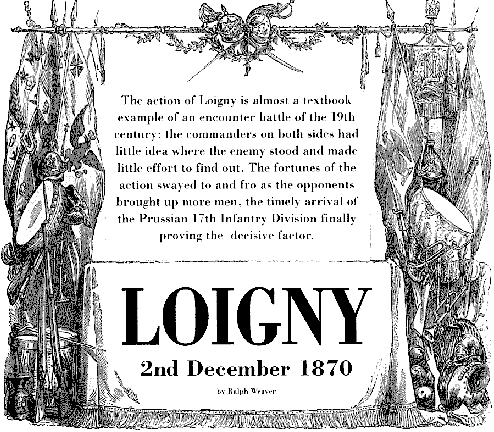
At the end of November 1870 the French republican government at Tours devised a plan for the breakout of the Army of Paris under General Ducrot. The Army of the Loire, consisting of several newly raised corps under the command of General d'Aurelle de Paladines, a veteran off Algeria and the Crimea, was sent instrution to effect a junction with Ducrot. Accordingly, three corps marched north on 1 December from their defensive camp in front of Orleans. The leading corp was the 16th, under Gen. de div. Chantzy (another experienced Algerian officer), and it fell in with the 1st Bavarian Infantry Division from the German detachment under the Grand Duke of Mecklenburh-Schwerin.
The French hailed the outcome as a victory which boosted morale and led to rumors that Ducrott wasn't far off. Leon Gambetta, the leader of the French government, made speeches as if success was assured.
The following day, the French command decided that one more push was all that was needed to break through the German forces. The 17th Corps was to form the pivot of the attack, which was to be led by the 16th Corps. The 15th Corps was to march direct for Paris.
On the morning of 2 December, 16th Corps mustered about 33,000 men, whereas the Bavarians, who had undergone a hard campaign, barely mustered 14,000, with many battalions reduced to 550 men.
Also on the 2nd, the grand duke of Mecklenburg-Schwerin ordered the Bavarians to prepare for an attack, which was to begin from their position between Orgeres-en-Beauce and the chateau of Goury. The Prussian 17th Div formed on the left, the Prussian 22nd Div in support. The bavarians has not begun to move when the French appeared out of the early morning mist, advancing on Loigny and Lumeau. The Bavarian 4th brigade was rushed in to the line and posted in the buildings and park of Goury. The 3rd brigade stood at Beauvilliers and the Prussian 4th Cavalry Div covered the open flank at Ogeres.
The French tried to take advantage of their superior numbers by launching massed attacks against Goury and Beauvilliers but the Bavarians held and even lauched counterattacks. A demonstration by German cavalry added to French hesitation, and a further Bavarian counterattack secured the well named farm of La Morale. Although the Bavarians here had halted the french advance, their small reserve was drawn and they had suffered considerable losses with 41 officers and over 600 men killed or wounded.
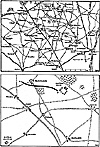
Large Maps (slow: 98K)
Jumbo Maps (extremely slow: 382K)
Events on another part of the Loigny battlefield took a different course. The French took control of Loigny, from which they could see the grey slate roof of the chateau of Goury, and Chantzy sent the 1st brigade of 16th Corps to eject the Bavarians. In the short time allowed for defense, the Bavarians had loopholed the walls and utilized every vantage point in order to bring fire upon the attackers.
The French pressed on to the chateau. The 3rd division of 16th Corps advanced from Terminiers, reached the edge of Lumeau and pressed on towards Baugneaux, threatening to outflank the Bavarians. At this moment the Prussian 17th Division arrived at the other en of Lumeau and raced to take possession of it before the French. Tresckow brought artillery with the van of the 17th Division, and the gunners quickly unlimibered and opened a heavy fire.
Further to the left, part of the 22nd Division took position by the hamlet of Anneux, and its guns added to the French discomfort. The French attempted to stand at Neuvilliers, but allowed no respite and soon a flood of troops were converging on Terminiers. With the immmediate danger past, Tresckow swung the 33rd Infantry Brigade to face Goury, and supported by eight batteries, these troops stormed into the right flank of the attacking French columns.
The chateau of Goury still stands little changed from the day of the battle. The Times correspondent took refuge there and his report shows the closeness of battle.
"It's spacious courtyard, flanked by two towers, and entered by an archway, was filled with soldiers, and the rooms to the right and the left were already full of German and French wounded, though it was not yet midday. Ascending to one of the towers in the chateau, I found myself in an admirable position tfor seeing the battle. The room was full of soldiers, who had loopholed the walls, but the enemy were not within range., or rather thought not to be so, until suddenly a large body of infantry, which was supposed to be German for the first moment or two, unexpectedly opened up a hot fire upon the regiment drawn up beneath the walls of the chateau.
Then from every loophole and crevise from the towers and walls rolled an incessant fire of rifles and the Chassepot balls seemed to rain upon the roofs and walls in reply until by degrees the old castle became the centre of the fight, and as it seemed to me, with every possible chance of being taken. The lieutenant in charge of the party in the loopholed chamber told me that it had been occupied at 2:00 in the morning, just ten minutes before the French could reach it, and that, in fact, the struggle for this position had opened the battle.
Unfortunatley, it was not yet over, and the room was getting so full of smoke, and the clatter of rifle balls on the roof was so unpleasant, that, fearing they might be followed by shot and shell, I dscended to the courtyard. Here, too, the ubiquitous Chassepot balls kept pinging about. The wall from the side of the French attack was very low, behind it were lying the German riflemen. drawing a fire from the enemy upon them, and consequently into the yard, which made it advisable for those who wished to cross to make a run for it.
Every available cover concealed a rifleman, but the enemy were closing round, and the fire became hotter, until it seemed to me that the moment was rapidly approaching when the chateau and all it contained would fall into the enemy's hands. The courtyard being as bad as the tower, and the rooms full of groaning wounded, I ascended again, like 'Sister Ann', to see if any help was coming, and arrived just in time to see through a loophole which a soldier kindly vacated. The Hanseatic Brigade come up on the double on the right flank of the enemy, while Prince Albrecht's cavalry appeeared most opportunly on the left.
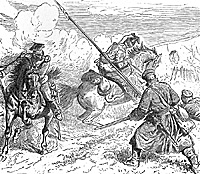 The French did not await the charge of the cavalry. They had made a gallant
fight of it, and it was no shame to them if, attacked on three sides, they fell
back on the hamlet, in which, I have already said, were French reserves. As
they did so, the men of the Free Towns opened up a terriffic fire upon them,
covering the field with killed and wounded. It was a great relief in one sense,
but so dearly purchased that it was hard to say which was more painful--the
prospect of being involved in hand-to-hand fighting inside the castle, or the
sight of the slaughter which had preserved such a fate. "
The French did not await the charge of the cavalry. They had made a gallant
fight of it, and it was no shame to them if, attacked on three sides, they fell
back on the hamlet, in which, I have already said, were French reserves. As
they did so, the men of the Free Towns opened up a terriffic fire upon them,
covering the field with killed and wounded. It was a great relief in one sense,
but so dearly purchased that it was hard to say which was more painful--the
prospect of being involved in hand-to-hand fighting inside the castle, or the
sight of the slaughter which had preserved such a fate. "
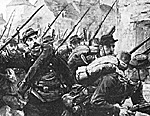 The French, taken unawares, fell back on Loigny, continually pressed by the
Germans. As the latter entered the village, they were treated to a heavy fire,
a sign that the French were not to be cowed easily. Every house was cleared
of defenders until they only remained defiant in the churchyard, where behind
the strong walls they held out even after all hope of relief had gone.
The French, taken unawares, fell back on Loigny, continually pressed by the
Germans. As the latter entered the village, they were treated to a heavy fire,
a sign that the French were not to be cowed easily. Every house was cleared
of defenders until they only remained defiant in the churchyard, where behind
the strong walls they held out even after all hope of relief had gone.
In the meantime, Bavarian commander von de Tann had his men supplied with fresh ammunitiion, and he now ordered the 1st Division to advance. The French Deplanque Brigade countered with a devastating demonstration of the power of the Chassepot and the Bavarians were stopped in ther tracks. A movement by the French cavalry division of Gen. Michele was spotted by the German cavalry, which quickly brought up their artillery; a few shots were enough to send Michel's men scuttling back out of range.
Chantzy was now beginning to realise that he was not going to relieve Paris that day, and he tried his best to cover those of his units which remained intact. He ordered some battalions from his reserve to form a line by the village of Terre-Noire. and 17th Corps, now arriving on the battlefield. provided help. A brigade, the 17th, formed at Faverolles and advanced towards Villours, in the direction of Villepion.
The commander of the 17th Corps, General de Division de Solis, led an attack in person, which included the Volontaires de l'Ouest, former Papal Zouves in their grey uniform embellished with red facings together with some local franc-tireurs . Their objective was bring relief to the defenders of Loigny, but they only covered 1500m before heavy losses from the fire of two battalions of the 15th Regiment brough them to a halt. Of the 300 'Volontaires' and 100 'franc-tireurs', 10 officers and 207 men were killed, wounded or missing, including Solis and Col. de Chartte of the Voluntares (see also Leonce Rousset, "Histoire generale de la guerre franco-allemande 1870-71. 6 volumes. Paris 1910-12).
The short winter day was drawing to a close and after Sonis' charge at 4.30pm, darkness brought an end to the fighting, the Germans occupying a line from Orgeres in the west to Lumeau in the east and the French still in Villepion, Faverolles and Terminiers. Aurelle de Paladin, who had been forced to take the offensive by the politicians. read the dispatches from his corp commanders and quickly decided that any further attempt by his army to break through to Paris would be useless. He therefore gave orders to fall back on Orleans, with the intention of pulling his army beyond the Loire River. The day had been costly to both sides. Casualties were roughly even at 4,000 killed and wounded, but the French had lost a further 2,500 as prisoners, in addition to a battery of eight guns and a mitrailleuse.
WARGAMING LOIGNY
The game was presented at the Victorian Military Fair by members of the Continental Wars Society. Initially the idea had been to present the whole battle which took place over a wide area of countryside around the villages of Loigny and Poupry. After some consideration, it became clear that this action was rather large for 15mm figures, and since it was almost two independent fights, it was proposed that we would attempt only that part centered on Loigny. The troops on the table were organized into units of 20 figures for French and Prussian and 16 for bavarians to represent their weakened state. Cavalry units were made up of 4 figures and for artillery, 1 gun represented half a battery.
WEAPONRY
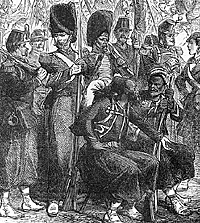
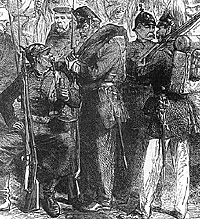 The French were armed predominantly with the excellent chassepot breach loading rifle. This had a longer range than the Prussian Dreyse, on the table 18" to the Prussian 10". The
Bavarians were equipped with a breach loader also, but this was converted from the Podewils mussle loader which has the reputation of being one of the poorest infantry weapons of the war.
The French were armed predominantly with the excellent chassepot breach loading rifle. This had a longer range than the Prussian Dreyse, on the table 18" to the Prussian 10". The
Bavarians were equipped with a breach loader also, but this was converted from the Podewils mussle loader which has the reputation of being one of the poorest infantry weapons of the war.
At the other end of the spectrum, the Bavarian Jagers carried a very modern breach loader--the Werder rifle--which was far superior to the Dreyse. Much of the French advantage was lost by the limited training thay had received. The Prussians and Bavarians were fully conversant with their weapons and handled them well. The artiliery was far superior to the French, it was well handled, generally in the front line and used in mass. The shells had percussion fuses as opposed to the French timed fuse which had to be set at one or two possible ranges. The advantage was reflected on the tabletop with the French limited to a 'killing zone' and the Germans capable of scoring hits at all ranges.
Large Illustration of French troops (slow: 182K)
Large Illustration of Prussian troops (slow: 182K)
MORALE
Up to 50% of the French were 'Garde Mobiles': volunteers with a modicum of training. They were generally not as reliable as regulars, and so a disdvantage was built into the game. This was archieved by giving them a 3'' move, with French regulars and Bavarians 4", and Prussians 5". The morale factors are similarly weighted , the Prussians start at +3, French and Bavarians at +2 and the Garde Mobiles at 0.
LEADERSHIP
The quality of the French leadership varied greatly. The army commander, Aurelle de Paladines. was a professional soldier, but he did not like the orders he had been asked to carry out, rightly considering that his poorly trained troops would not be a match for the Germans. He was forced to undertanke the advance on Paris which he did with what was available.
The 16th Corps was led by General Chanzy, an above average commander. The 17th Corps was unfortunately commanded by General de Sonis, a brave man but one who shouldn't really have been promoted above colonel. The divisional and brigade commanders were of average competence.
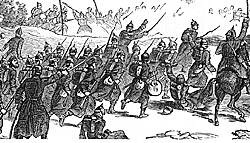 The Germans were also blessed with a mixed bag of senior officers. The army commander,
Mecklenburg-S'hwerin was a solid, if unimaginative leader. who could be relied upon to carry
out orders. The Bavarian commander, General of Infantry vonand zu der Tann-Rathsamhausen was
an experienced, if unfortunate officer who had campaigned in Denmark in 1848 and Germany in
1866 with a singular lack of success. Von Tresckow, commander of the Prussian l7th Division, on the other hand, was a daring and resourceful leader, mich above average. The brigade commanders were all thoroughly professional soldiers, well trained to take advantage of any opportunity--ranked above average.
The Germans were also blessed with a mixed bag of senior officers. The army commander,
Mecklenburg-S'hwerin was a solid, if unimaginative leader. who could be relied upon to carry
out orders. The Bavarian commander, General of Infantry vonand zu der Tann-Rathsamhausen was
an experienced, if unfortunate officer who had campaigned in Denmark in 1848 and Germany in
1866 with a singular lack of success. Von Tresckow, commander of the Prussian l7th Division, on the other hand, was a daring and resourceful leader, mich above average. The brigade commanders were all thoroughly professional soldiers, well trained to take advantage of any opportunity--ranked above average.
TERRAIN
Loigny lies in the valley of the Loire River, in an open plain dotted with farms and village, The wooded areas present only a small hindrance to movement, say 1" off the rates listed above, and provide soft cover. The battle took place in winter so there would not be much foliage, which is why woods do not provide complete cover.
DEPLOYMENT ETC.
At the start of the game, the Bavarians occupy thenorthern portion of the table along the line A-B on the map. German cavalry is positioned on the right flank but the left flank is open. The French enter from the south, either in column or already deployed and make Loigny their objective. The Germans to deny it. Neither side is fully aware of the enemy strength. The French can bring on the whole of the 16th Corps which will give them a marked superiority, and they may outflank and attempt to take the Chateau of Goury in whic a small Bavarian garrison has been placed. A number of moves must be allowed the French, say, at least 10, before the Prussian 17th Division appears at Lumeau. A further interval, say 5 more turns, must pass before the leading elements of Corps de Sonis are considered to have appeared, leaving 2 or 3 turns left before the end of the game.
Victory
German: Halt the French
French: Sweep the Germans aside.
Notes
The main feature of the rules (adapted from "A berlin" by Philip Robinson in Wargames Illustrated, May 1994) was the devastating firepower of the French Chassepot. The Germans had to cross this killing ground as quickly as possible or to bring up artillery and weaken the French before going in with the bayonet. This firepower was good in the defense, but loses some effectiveness in the attack. The campaign along the Loire provides a dozen or more scenarios similar to this one.
Playing the Game
The initial superiority of the French is a great advantage, and they managed to establish themselves in Loigny, which they managed to cling to for the battle. The French then made a great demonstration to the east of the village which kept Bavarian attention on that part of the field. While some of the French worked their way forward against the Bavarian artillery, other French regiments were sweeping to the west of Loigny without encountering opposition. A further cavalry patrol towards Lumeau attracted little attention. This situation persisted for some time, with neither side gaining much. By the time the show closed, the advancing gemans 17th Div. had failed to make its presence felt and the French were confident of securing victory.
Order of Battle
FRENCH
16th Corps
General de Division Chanzy
1st DIVISION Rear-Admiral Jaureguilberry
- 1st Brigade - General Bourdillon
- 39th Provisional Regt (3)
75th Regt ot'Gardes Mobiles' (3)
3rd Provisional Chasseur Battalion
2nd Brigade - General de Brigade Deplanque
- 37th Provisional Regt (3)
33rd Regt of Gardes Mobiles'
3 Batteries (18 guns)
2nd DIVISION General de Division Barry
- 1st Brigade - Colonel Desmaisons
- 31st Provisional Regt (3)
22nd Regt of 'Gardes Mobiles' (3)
7th Provisional Chasseur Battalion
2nd Brigade Colonel Berar
- 38th Provisional Regt (3)
66th Regt of 'Gardes Mobiles' (3)
3 batteries (18 guns)
3rd DIVISION General Morandy
-
1st Brigade Colonel Marty
- 36th Provisional Regt (3)
8th Regt of 'Gardes Mobile' (3)
8th Provisional Chasseur Battalion
2nd Brigade - General Seatilli or General d'Aries
- 40th Provisional Regt (3)
71st Regt of 'Gardes Mobiles' (3)
3 Batteries (18 guns)
CAVALRY DIVISION General Morandy
- 1st Brigade - General Tripardy
-
1st Provisional Hussar Regt (4)
2nd Mixed Provisional Light Cavalry Regt (4)
2nd Brigade - General Digardy
-
6th Lancer Regt (4)
3rd Mixed Provisional Light Cavalry Regt (4)
3rd Brigade - General de Truce
-
3rd Provisional Cuirassier Regt (4)
4th Provisional Dragoon Regt (4)
4th Mixed Provisional Light Cavalry Regt
Reserve Artillery - Lt Colonel Carre
- 11 Batteries (66 guns)
German
1st Bavarian Corps
General of Infantry von der Tann-Rathsamhausen
1st INFANTRY DIVISION Lt General von Stephan
- 1st Brigade - Major General von Dietl
- 'Infantrie-Lieb-Regt' (3)
1st Infantry Regt (2)
2nd Jager Battalion
2nd Infantry Brigade - Major General von Orff
- 2nd Infantry Regt (3)
11th Infantry Regt (2)
4th Jager Battalion
Reserve
- 9th Jager Battalion
3rd Chavaulegers Regt (4)
4 Batteries (24 guns)
2nd INFANTRY DIVISION Lt General Maillinger
- 3rd Brigade - Major General Roth
- 3rd Infantry Regt (3)
12th Intantry Regt (3)
1st Jager Battalion
4th Brigade - Major-General von der Tann
- 10th Infantry Regt (3)
13th Infantry Regt (3)
7th Jager Battalion
Reserve
- 4rd Chevaulegers Regt (4)
24 Batteries (24 guns)
Cuirassier Brigade - Major General von Tauch
- 1st Cuirassier Regt (4)
2nd Cuirassier Regt (4)
1 Horse Battery (6 guns)
Artillery Reserve
- 12 Batteries (64 guns)
PRUSSIAN 17th INFANTRY DIVISION Lt General von Treschow
-
33rd Infantry Brigade Major General von Kottwitz
- 75th Infantry Regt (3)
76th Infantry Regt (3)
34rd Infantry Brigade Colonel von Manteuffel
- 89th Grenadier Regt (3)
90th Fusilier Regt (3)
14th Lancer Regt (4)
17th Cavalry Brigade Major General von Rauch
- 17th Dragoon Regt (4)
18th Dragoon Regt (4)
4 Batteries (36 guns)
4th CAVALRY DIVISION (part) General Prince Albrecht of Prussia the Elder
-
9th Cavalry Brigade Major General von Bernhardi
- 1st Lancer Regt
6th Lancer Regt (6)
10th Cavalry Brigade Major General von Kroksigk
- 5th Dragoon Regt (4)
2nd Hussar Regt (4)
2 Horse Batteries (12 guns)
The figures in brackets give the number of battalions/squadrons present.
Back to Age of Empires Issue 13 Table of Contents
Back to Age of Empires/ Colonial Conquest List of Issues
Back to MagWeb Master List of Magazines
© Copyright 1997 by Partizan Press.
This article appears in MagWeb (Magazine Web) on the Internet World Wide Web.
Other military history articles and gaming articles are available at http://www.magweb.com